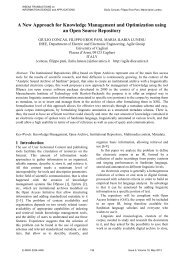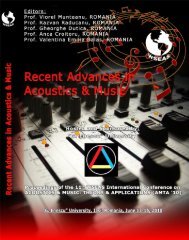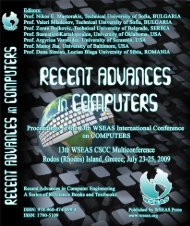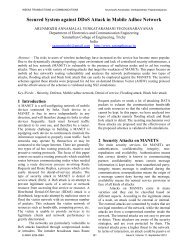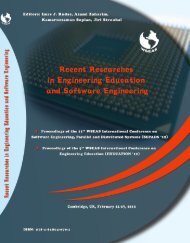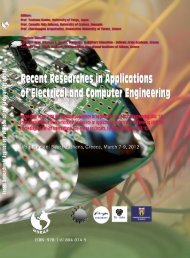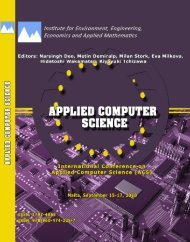Heuristic Search Method for Digital IIR Filter Design - WSEAS
Heuristic Search Method for Digital IIR Filter Design - WSEAS
Heuristic Search Method for Digital IIR Filter Design - WSEAS
You also want an ePaper? Increase the reach of your titles
YUMPU automatically turns print PDFs into web optimized ePapers that Google loves.
<strong>WSEAS</strong> TRANSACTIONS on SIGNAL PROCESSING<br />
Ranjit Kaur, Manjeet Singh Patterh,<br />
J. S. Dhillon, Damanpreet Singh<br />
<strong>Heuristic</strong> <strong>Search</strong> <strong>Method</strong> <strong>for</strong> <strong>Digital</strong> <strong>IIR</strong> <strong>Filter</strong> <strong>Design</strong><br />
RANJIT KAUR 1 , MANJEET SINGH PATTERH 2 , J.S. DHILLON 3 , DAMANPREET SINGH 4<br />
Department of Electronics & Communication 1,2 , Department of Electrical & Instrumentation 3<br />
Department of Computer Science 4<br />
University College of Engineering 1,2 , Sant Longowal Institute of Engineering & Technology 3,4<br />
Punjabi University, Patiala 1,2 , Longowal 3,4<br />
INDIA<br />
ranjit24_ucoe@pbi.ac.in 1 , mspattar@pbi.ac.in 2 , jsdhillon@sliet.ac.in 3 , damanpreetsingh@sliet.ac.in 4<br />
Abstract: - The paper develops innovative methodology <strong>for</strong> robust and stable design of digital infinite impulse<br />
response (<strong>IIR</strong>) filters using a heuristic search method. The proposed heuristic search method enhances the<br />
capability to explore and exploit the search space locally as well globally to obtain optimal filter design<br />
parameters. A multicriterion optimization is employed as design criterion to obtain optimal stable <strong>IIR</strong> filter that<br />
satisfies different per<strong>for</strong>mance requirements like minimizing L p -norm approximation error and ripple<br />
magnitude. Multicriterion optimization problem has been solved applying weighted sum method and p-norm<br />
method. Best weight pattern is searched using evolutionary search method that minimizes the per<strong>for</strong>mance<br />
criteria simultaneously. The proposed heuristic search method is effectively applied to solve the multicriterion,<br />
multiparameter optimization problems of low-pass, high-pass, band-pass, and band-stop digital filters design.<br />
The computational experiments show that the proposed heuristic search method is superior or atleast<br />
comparable to other algorithms and can be efficiently used <strong>for</strong> higher filter design.<br />
Key-Words: - <strong>Digital</strong> infinite impulse response filters, <strong>Heuristic</strong> search algorithm, Multicriterion optimization,<br />
Magnitude Response, Stability, L p -norm error.<br />
1 Introduction<br />
<strong>Digital</strong> infinite impulse response (<strong>IIR</strong>) filter design<br />
has attracted growing attention due to their<br />
important role in the field of denoising of digital<br />
images, artificial vision, biomedical imaging, digital<br />
mammography, satellite image processing and many<br />
other scientific applications. <strong>Digital</strong> <strong>IIR</strong> filter design<br />
principally follows two techniques: trans<strong>for</strong>mation<br />
technique and optimization technique. In<br />
trans<strong>for</strong>mation technique, first analog <strong>IIR</strong> filter is<br />
designed and is transferred to digital <strong>IIR</strong> filter.<br />
Several well-known filter design approaches, such<br />
as Butterworth, Chebyshev and Elliptic function,<br />
have been developed using trans<strong>for</strong>mation<br />
techniques [1]. In accordance, the MATLAB<br />
toolbox provides a user-friendly Interface <strong>for</strong> filter<br />
designing [2]. The problem of designing <strong>IIR</strong> filters<br />
has been tackled using various optimizatioqn<br />
techniques such as p-error, weighted least square<br />
and ripple magnitudes (tolerances) of both passband<br />
and stop-band [4]-[6]. As compared to finiteimpulse-response<br />
(FIR) filters digital <strong>IIR</strong> filters<br />
often per<strong>for</strong>m better and have less computation cost.<br />
Different iterative design techniques <strong>for</strong> <strong>IIR</strong> filters<br />
using the Steiglitz-McBride (SM) scheme [3] have<br />
been proposed in [4]-[8]. At each iteration, the<br />
denominator of an approximation error is replaced<br />
by its equivalent obtained at the previous iteration<br />
and is combined with a weighting function. Then,<br />
the approximation error to be minimized can be<br />
described as a quadratic function of filter<br />
coefficients. Different stability constraints based on<br />
argument Principle [8] and the positive realness<br />
based stability constraint [4]–[7] have been<br />
employed to guarantee the stability of designed <strong>IIR</strong><br />
filters. However due to non-linear and multimodal<br />
nature of error surface of <strong>IIR</strong> filters, conventional<br />
gradient-based design may easily get stuck in the<br />
local minima of error surface. There<strong>for</strong>e, researchers<br />
have developed design methods based on modern<br />
heuristics optimization algorithms such as genetic<br />
algorithms [9]-[14], particle swarm optimization<br />
[15], seeker-optimization-algorithm [16], simulated<br />
annealing [17], tabu search [18], ant colony<br />
optimization [19], immune algorithm [21] and many<br />
more.<br />
A genetic algorithm is a probabilistic search<br />
technique that is based on the principles of genetics.<br />
Mainly, genetic algorithms are inspired by<br />
evolutionary biology such as inheritance, mutation,<br />
natural selection, and crossover. Since its outset,<br />
genetic algorithm has been extensively used as a<br />
tool in computer programming, artificial intelligence<br />
and optimization. The genetic algorithm based<br />
optimization methods are not only capable of<br />
E-ISSN: 2224-3488 121 Issue 3, Volume 8, July 2012
<strong>WSEAS</strong> TRANSACTIONS on SIGNAL PROCESSING<br />
Ranjit Kaur, Manjeet Singh Patterh,<br />
J. S. Dhillon, Damanpreet Singh<br />
searching multidimensional and multimodal spaces,<br />
but are also able to optimize complex and<br />
discontinuous functions that are difficult to analyze<br />
mathematically. The use of the genetic algorithm <strong>for</strong><br />
the digital <strong>IIR</strong> filter design is practical and attractive<br />
[10] as the filter can be constructed in any <strong>for</strong>m,<br />
such as cascade, parallel, or lattice and also the lowpass<br />
(LP), high-pass (HP), band-pass (BP), and<br />
band-stop (BS) filters can be independently<br />
designed. Further the classical analog-to-digital<br />
trans<strong>for</strong>mation is avoided. Multiobjective functions<br />
can be simultaneously solved and the obtained<br />
model can be of the lowest order. Un<strong>for</strong>tunately, the<br />
per<strong>for</strong>mance of genetic algorithm based methods is<br />
often compromised by their very slow convergence<br />
and they may be trapped in the local optima of the<br />
multiobjective functions when the number of the<br />
parameters is large and there are numerous local<br />
optima [22]. There<strong>for</strong>e, it is worthy of further<br />
developing an efficient heuristic algorithm to solve<br />
the problem of designing the optimal digital <strong>IIR</strong><br />
filters. A hybrid Taguchi genetic algorithm has been<br />
applied by Tsai et al. [23] to solve the problem of<br />
designing optimal digital <strong>IIR</strong> filters. The hybrid<br />
Taguchi genetic algorithm approach is a method of<br />
combining the traditional genetic algorithms, which<br />
has a powerful global exploration capability, with<br />
the Taguchi method, which can exploit the optimum<br />
offspring. The Taguchi method is inserted between<br />
crossover and mutation operations of traditional<br />
genetic algorithms. While genetic algorithm rapidly<br />
locates good solutions, even <strong>for</strong> difficult search<br />
spaces, it has some disadvantages associated with it:<br />
genetic algorithm may converge towards local<br />
optima rather than global optima if the fitness<br />
function is not defined properly; it is difficult to<br />
operate genetic algorithm on dynamic sets.<br />
Conventional optimization algorithms may find<br />
better solutions than genetic algorithm in same<br />
computation time.<br />
Particle swarm optimization technique attains<br />
high quality solutions within shorter calculation<br />
time and stable convergence characteristics than<br />
other stochastic methods such as genetic algorithm<br />
by virtue of being population based optimization<br />
algorithm. Based on a variation of particle swarm<br />
optimization, namely, quantum-behaved particle<br />
swarm optimization, Sun et al.[24] have proposed<br />
quantum-behaved particle swarm optimization with<br />
diversity-guided mutation <strong>for</strong> the design of 2-D <strong>IIR</strong><br />
digital filters. The per<strong>for</strong>mance of particle swarm<br />
optimization or its variants depends on its<br />
parameters and may be influenced by premature<br />
convergence and stagnation problem [25]. A seekeroptimization-algorithm-based<br />
evolutionary method<br />
has been proposed by Dai et al. [16] <strong>for</strong> digital <strong>IIR</strong><br />
filter design. Seeker optimization algorithm is based<br />
on the concept of simulating the act of human<br />
searching in which the search direction is based on<br />
the empirical gradient by evaluating the response to<br />
the position changes and the step length is based on<br />
uncertainty reasoning by using a simple fuzzy rule.<br />
Although seeker-optimization-algorithm is easy to<br />
be implemented and good at local convergence,<br />
depending upon the initial solution, it might often<br />
require too many cost function evaluations to<br />
converge to the global minima [16].<br />
Recent heuristic method, namely immune<br />
algorithms mimic the antigen-antibody reaction of<br />
the immune system in mammals. The antigen and<br />
the antibody in the immune algorithms are<br />
equivalent to the objective function and the feasible<br />
solution <strong>for</strong> a conventional optimization method.<br />
The clonal selection principle of immune algorithms<br />
facilitates the efficiency of solving the numerical<br />
optimization problems. However, the characteristics<br />
of the immune algorithms are similar to those of the<br />
traditional genetic algorithms, which are largely<br />
based on the stochastic search techniques, have<br />
larger standard deviations. The obtained result is<br />
more robust if the relevant fitness values have a<br />
smaller standard deviation. A robust approach by<br />
integrating the immune algorithm and the Taguchi<br />
method named as Taguchi-immune algorithm has<br />
been purposed by Tsai and Chou [21] . Cooperative<br />
co-evolutionary genetic algorithm <strong>for</strong> digital <strong>IIR</strong><br />
filter design has been proposed by Yu et al. [26].<br />
The magnitude response and the phase response has<br />
been considered simultaneously and also tried to<br />
find the lowest filter order. The structure and the<br />
coefficients of the digital <strong>IIR</strong> filter have been coded<br />
separately, and they evolve coordinately as two<br />
different species, i.e., the control species and the<br />
coefficient species. The non-dominated sorting<br />
genetic algorithm-II has been used <strong>for</strong> the control<br />
species to guide the algorithms toward three<br />
objectives simultaneously. The simulated annealing<br />
has been used <strong>for</strong> the coefficient species to keep the<br />
diversity but it may require too many function<br />
evaluations to arrive at global minima [17]. Various<br />
methods exist in the literature that addresses the<br />
optimization problem under different conditions.<br />
Different optimization methods are classified based<br />
on the type of the search space and the objective<br />
function. In <strong>IIR</strong> filter design problems, the<br />
evaluation of candidate solutions could be<br />
computationally and/or financially expensive since<br />
it requires time-consuming computer simulation or<br />
expensive physical experiments. There<strong>for</strong>e, a<br />
method is of great practical interest if it is able to<br />
E-ISSN: 2224-3488 122 Issue 3, Volume 8, July 2012
<strong>WSEAS</strong> TRANSACTIONS on SIGNAL PROCESSING<br />
Ranjit Kaur, Manjeet Singh Patterh,<br />
J. S. Dhillon, Damanpreet Singh<br />
produce reasonably good solutions within a given<br />
(often very tight) budget on computational<br />
cost/time. This paper aims at developing such a<br />
method <strong>for</strong> approximating the Pareto front of an<br />
expensive multiobjective optimization problem<br />
exploiting evolutionary search and heuristic<br />
approach.<br />
The intent of this paper is to propose a heuristic<br />
method that randomly explores the search space <strong>for</strong><br />
the best solution locally as well globally <strong>for</strong> the<br />
design of <strong>IIR</strong> filters. The heuristic method proposed<br />
is a combination of exploratory move and pattern<br />
move which are made iteratively to search optimal<br />
design of <strong>IIR</strong> filter. The unique combination of<br />
broad exploration and further exploitation yields a<br />
powerful option to solve multimodal optimization<br />
problems that designs <strong>IIR</strong> filters. The values of the<br />
filter coefficients are optimized with the heuristic<br />
algorithm to achieve L p -norm error criterion in terms<br />
of magnitude response and ripples both in pass band<br />
and stop band as objective functions <strong>for</strong><br />
multiobjective optimization problem. Multicriterion<br />
optimization problem is converted into scalar<br />
constrained optimization problem employing<br />
weighting p-norm method. The weighting technique<br />
is used to generate non-inferior solutions, which<br />
allow explicit trade-off between conflicting<br />
objective levels. The weighting patterns are either<br />
presumed on the basis of decision maker’s intuition<br />
or simulated with suitable step size variation.<br />
Further the weightage pattern can also be searched<br />
in the non-inferior domain. In the paper, the<br />
weightage pattern is searched using Evolutionary<br />
search technique. Constraints are taken care of by<br />
applying exterior penalty method.<br />
The paper is organized as follows. Section 2<br />
describes the <strong>IIR</strong> filter design problem statement.<br />
The underlying mechanism and details regarding the<br />
methodology of the heuristic search algorithm <strong>for</strong><br />
designing the optimal digital <strong>IIR</strong> filters is described<br />
in Section 3. In Section 4, the per<strong>for</strong>mance of the<br />
proposed heuristic search method has been<br />
evaluated and achieved results are compared with<br />
the design results by Tang et al. [10], Tsai et al. [23]<br />
and Tsai and Chou [21] <strong>for</strong> the low-pass, high-pass,<br />
band-pass, and band-stop filters. Finally, the<br />
conclusions and discussions are outlined in Section<br />
5.<br />
2 <strong>Filter</strong> <strong>Design</strong> Problem<br />
<strong>Digital</strong> filter design problem involves the<br />
determination of a set of filter coefficients which<br />
meet per<strong>for</strong>mance specifications such as pass-band<br />
width and corresponding gain, width of the stopband<br />
and attenuation, band edge frequencies and<br />
tolerable peak ripple in the pass band and stop-band.<br />
The traditional design of the <strong>IIR</strong> filter is described<br />
by the following difference equation:<br />
y(<br />
n)<br />
<br />
M<br />
<br />
k0<br />
p x(<br />
n k)<br />
<br />
k<br />
N<br />
<br />
k1<br />
q y(<br />
n k)<br />
k<br />
(1)<br />
where p k<br />
and q k<br />
are the coefficient of the filter.<br />
x(n)<br />
and y(n)<br />
are filter input and output. M and N<br />
are the number of p k<br />
and q k<br />
filter coefficients, with<br />
N≥M.<br />
The transfer function of <strong>IIR</strong> filter is stated as<br />
below:<br />
U<br />
<br />
k<br />
p z k<br />
k 0<br />
H ( z)<br />
<br />
V<br />
(2)<br />
1<br />
q<br />
k<br />
z<br />
<br />
<br />
k 1<br />
k<br />
To design digital filter a set of filter coefficients<br />
p k<br />
and q k<br />
are determined, which meet the desired<br />
per<strong>for</strong>mance indices. A popular way of realizing <strong>IIR</strong><br />
filters is to cascade many first- and second-order<br />
sections together [11] to avoid the coefficient<br />
quantization problem which causes instability. The<br />
structure of cascading type digital <strong>IIR</strong> filter is:<br />
M<br />
j<br />
1<br />
p e <br />
<br />
1i<br />
H ( ,<br />
x)<br />
<br />
<br />
<br />
j<br />
i1 1<br />
q1<br />
ie<br />
<br />
(3)<br />
N<br />
j<br />
2<br />
j<br />
1<br />
r <br />
1ke<br />
r2<br />
ke<br />
<br />
<br />
<br />
j<br />
2<br />
j<br />
k 1<br />
1<br />
s1<br />
ke<br />
s2ke<br />
<br />
where<br />
x [ p , q ,..., p , q , r11,<br />
r21,<br />
s11,<br />
s21,...,<br />
r1N<br />
, r2N<br />
, 1N<br />
,<br />
11 11 1M<br />
1M<br />
s<br />
T<br />
2N<br />
, and Vector x denotes the filter coefficients<br />
s ]<br />
of first and second order sections of dimension V×1<br />
with V = 2M + 4N + 1.<br />
The <strong>IIR</strong> filter is designed by optimizing the<br />
coefficients such that the approximation error<br />
function in L p -norm and using fixed grid approach<br />
[20] <strong>for</strong> magnitude is to be minimized. The<br />
magnitude response is specified at K equally spaced<br />
discrete frequency points in pass-band and stopband.<br />
e1 ( x)<br />
denotes the absolute error L 1 -norm of<br />
magnitude response and e 2(<br />
x ) denotes the squared<br />
error L 2 -norm of magnitude response and are<br />
defined as given below:<br />
<br />
K<br />
1<br />
( x)<br />
H<br />
d<br />
(<br />
i<br />
) H(<br />
i,<br />
x)<br />
i0<br />
e<br />
e<br />
(4)<br />
K<br />
2<br />
H<br />
( ) H(<br />
, x <br />
d i<br />
i<br />
( x)<br />
<br />
)<br />
2<br />
i0<br />
(5)<br />
Desired magnitude response H d<br />
( i<br />
) of <strong>IIR</strong> filter is<br />
given as:<br />
E-ISSN: 2224-3488 123 Issue 3, Volume 8, July 2012
<strong>WSEAS</strong> TRANSACTIONS on SIGNAL PROCESSING<br />
Ranjit Kaur, Manjeet Singh Patterh,<br />
J. S. Dhillon, Damanpreet Singh<br />
1,<br />
<strong>for</strong> i<br />
passband<br />
H<br />
d<br />
( i<br />
) <br />
(6)<br />
0,<br />
<strong>for</strong> i<br />
stopband<br />
The ripple magnitudes are to be minimized of passband<br />
and stop-band, which are denoted by<br />
( ) and ( ) respectively. Ripple magnitudes are<br />
1 x<br />
2 x<br />
defined as:<br />
x)<br />
max H(<br />
, x)<br />
min H(<br />
, x)<br />
<br />
1(<br />
i<br />
i<br />
i<br />
i<br />
(7)<br />
<strong>for</strong>i<br />
passband<br />
and<br />
<br />
2(<br />
x)<br />
maxH<br />
( i,<br />
x)<br />
<strong>for</strong> i<br />
stopband (8)<br />
i<br />
Aggregating all objectives and stability constraints,<br />
the multi-criterion constrained optimization problem<br />
is stated as:<br />
Minimize f x)<br />
e ( )<br />
1( 1<br />
x<br />
2( x)<br />
e2<br />
( x<br />
3( x)<br />
1(<br />
x<br />
4( x)<br />
<br />
2(<br />
x<br />
Minimize f )<br />
Minimize f )<br />
Minimize f )<br />
(9a)<br />
Subject to: the stability constraints:<br />
1 q1 i<br />
0 ( i 1,2,....,<br />
M)<br />
(9b)<br />
1 q1 i<br />
0 ( i 1,2,....,<br />
M)<br />
(9c)<br />
1 s2 k<br />
0 ( k 1,2,....,<br />
N)<br />
(9d)<br />
1 s1 k<br />
s2k<br />
0 ( k 1,2,....,<br />
N)<br />
(9e)<br />
1 s1 k<br />
s2k<br />
0 ( k 1,2,....,<br />
N)<br />
(9f)<br />
The multiple-criterion constrained optimization<br />
problem <strong>for</strong> the design of digital <strong>IIR</strong> filter is<br />
converted into a scalar constrained optimization<br />
problem by using a weighted sum of the objectives<br />
to generate non-inferior solutions.<br />
<br />
L<br />
<br />
<br />
p<br />
p<br />
Minimize f ( x)<br />
<br />
wj f<br />
j<br />
( x)<br />
<br />
(10)<br />
j1<br />
<br />
such that(1 p )<br />
Subject to: The satisfaction of stability constraints<br />
given by Eq. (9b) to Eq. (9f).<br />
Where f j<br />
(x)<br />
is the j th objective function, and w is<br />
j<br />
non-negative real number called weight assigned to<br />
j th objective. This approach yields meaningful<br />
results when solved many times <strong>for</strong> different values<br />
of w<br />
j<br />
, (j = 1, 2,..., L). The p-norm weighting<br />
patterns are either presumed on the basis of decision<br />
maker’s intuition or simulated with suitable step<br />
size variation. A problem with the weighted sum<br />
technique arises when the lower boundary of<br />
function space is not convex [27], because not every<br />
non-inferior solution will have a supporting hyperplane.<br />
In case, the non-inferior surface is nonconvex<br />
the weighted sum method may yield poor<br />
<br />
1<br />
designs no matter what weight or optimization<br />
technique is used. The paper presents a systematic<br />
weight selection heuristics using Evolutionary<br />
search technique. The weight selection techniques<br />
used in a digital filter design have been discussed by<br />
Cortelazzo and Lightner [27]. The design of causal<br />
recursive filters requires the inclusion of stability<br />
constraints. There<strong>for</strong>e, the stability constraints given<br />
by Eq. (9b) to Eq. (9f) which are obtained by using<br />
the Jury method [28] on the coefficients of the<br />
digital <strong>IIR</strong> filter in Eq. (3) are included in the<br />
optimization process. Scalar constrained<br />
optimization problem is converted into<br />
unconstrained multivariable optimization problem<br />
using penalty method. Augmented function is<br />
defined as in Eq. 10 with p=1 is defined as:<br />
A(<br />
x)<br />
<br />
where<br />
c <br />
d <br />
M<br />
<br />
i1<br />
N<br />
<br />
k1<br />
L<br />
<br />
j1<br />
1<br />
q<br />
w f ( x)<br />
r c d<br />
j<br />
1i<br />
1<br />
s<br />
1k<br />
j<br />
2<br />
<br />
s<br />
M<br />
<br />
i1<br />
2k<br />
2<br />
<br />
1<br />
q<br />
<br />
N<br />
<br />
1i<br />
k1<br />
<br />
2<br />
<br />
1<br />
s<br />
N<br />
<br />
k1<br />
1k<br />
1<br />
s<br />
s<br />
2k<br />
2k<br />
2<br />
2<br />
(11)<br />
r is a penalty parameter having large value. Bracket<br />
function <strong>for</strong> constraint given by Eq. (9b) is stated<br />
below:<br />
<br />
1<br />
q1<br />
i<br />
if 1<br />
q1<br />
i<br />
0<br />
1<br />
q<br />
1i<br />
<br />
(12)<br />
0<br />
if (1 q1<br />
i<br />
) 0<br />
Similarly bracket functions <strong>for</strong> other constraints<br />
given by Eq. (9c) to Eq. (9f) are undertaken.<br />
3 <strong>Heuristic</strong> <strong>Search</strong> Approach <strong>for</strong> the<br />
<strong>Design</strong> of <strong>IIR</strong> <strong>Filter</strong><br />
A heuristic search is used to describe a sequential<br />
examination of trial solutions. The procedure of<br />
going from a given point to the next improved point<br />
is called a ‘move’. A move is termed a ‘success’ if<br />
the objective improves; otherwise, it is a ‘failure’.<br />
The heuristic search routine makes four types of<br />
moves. The first move is random initialization.<br />
Random initialization has been framed to acquire<br />
best starting point. The second move is exploratory<br />
move designed to acquire knowledge concerning the<br />
behavior of the function. This move is per<strong>for</strong>med in<br />
the vicinity of the current point systematically to<br />
find the best point around the current point. The<br />
third move is a pattern move with random<br />
acceleration factor. Weight Pattern search based on<br />
evolutionary search method is applied to search the<br />
normalized weights, w ( i 12 , ,...,L)<br />
assigned to<br />
i<br />
<br />
E-ISSN: 2224-3488 124 Issue 3, Volume 8, July 2012
<strong>WSEAS</strong> TRANSACTIONS on SIGNAL PROCESSING<br />
Ranjit Kaur, Manjeet Singh Patterh,<br />
J. S. Dhillon, Damanpreet Singh<br />
participating objectives and are utilized to generate<br />
the non-inferior solutions.<br />
3.1 Random Initialization<br />
In random Initialization the starting point is found<br />
with the help of random search. Global search is<br />
applied to explore the starting point and then the<br />
starting point is perturbed in local search space to<br />
record the best starting point. The search process is<br />
j<br />
started by initializing the variable x<br />
i<br />
using Eq. (13)<br />
which is used to calculate objective function using<br />
Eq. (3).<br />
j min j max min<br />
xi<br />
xi<br />
r1<br />
( xi<br />
xi<br />
)<br />
(13)<br />
( i 1,2,...,<br />
V ; j 1,2,...,<br />
NV )<br />
where r i<br />
is a random generated number, V is number<br />
of variables, NV is the population size.<br />
The concept of opposition-based learning has<br />
been applied to accelerate rein<strong>for</strong>cement learning<br />
and back-propagation learning in neural networks<br />
[29]. The main idea behind opposition-based<br />
learning is the simultaneous consideration of an<br />
estimate and its corresponding opposite estimate<br />
(i.e., guess and opposite guess) in order to achieve a<br />
better approximation <strong>for</strong> the current candidate<br />
solution. The opposition based strategy is applied<br />
j<br />
and starting point xi<br />
is further explored using Eq.<br />
(14) to record the best starting point.<br />
j1<br />
max j max min<br />
xi<br />
xi<br />
r2<br />
( xi<br />
xi<br />
)<br />
(14)<br />
( i 1,2,...,<br />
V ; j 1,2,...,<br />
NV )<br />
Out of 2 x NV members, best NV members<br />
constitute pool to initiate the process. For the global<br />
search best single, member is selected out of local<br />
best population. The stepwise flowchart <strong>for</strong> the<br />
initialization of filter coefficients and local search<br />
are given in Fig. 1 and Fig. 2.<br />
3.2 Exploratory Move<br />
In the exploratory move, the current point is<br />
perturbed in positive and negative directions along<br />
each variable one at a time and the best point is<br />
recorded. The current point is changed to the best<br />
point at the end of each variable perturbation may<br />
either be directed or random. If the point found at<br />
the end of all variable perturbations is different from<br />
the original point, the exploratory move is a success;<br />
otherwise, the exploratory move is a failure. In any<br />
case, the best point is considered to be the outcome<br />
of the exploratory move. The starting point obtained<br />
with the help of random initialization is explored<br />
iteratively and variable xi<br />
is initialized as follows:<br />
n o j<br />
x x u ( i 1,2,...,<br />
V ; j 1,2,...,<br />
V ) (15)<br />
i<br />
where<br />
1<br />
u j<br />
i<br />
<br />
0<br />
i<br />
i<br />
i<br />
i j<br />
i j<br />
where NV denotes number of variables.<br />
(16)<br />
The objective function denoted by f ( x i<br />
) is<br />
calculated as follows<br />
o<br />
o<br />
o<br />
xi<br />
i<br />
ui<br />
; f ( xi<br />
i<br />
ui<br />
) f ( xi<br />
)<br />
n o<br />
o<br />
o<br />
xi<br />
xi<br />
i<br />
ui<br />
; f ( xi<br />
i<br />
ui<br />
) f ( xi<br />
) (17)<br />
o<br />
xi<br />
; Otherwise<br />
where ( i 1,2,...,<br />
V ) and Δi<br />
is random <strong>for</strong> global<br />
search and fixed <strong>for</strong> local search.<br />
The process is repeated till all the variables are<br />
explored and overall minimum is selected as new<br />
starting point <strong>for</strong> next iteration. The stepwise<br />
flowchart to explore filter coefficients is outlined in<br />
Fig. 3.<br />
3.3 Pattern Move<br />
The pattern move utilizes the knowledge acquired in<br />
the exploratory move and attains the minimization<br />
of the function by moving in the direction of an<br />
established ‘pattern’. A new point is calculated by<br />
leaping from current best point<br />
x along a direction<br />
o<br />
connecting previous best point xi<br />
and is executed as<br />
given below:<br />
n c c o<br />
xi<br />
xi<br />
( xi<br />
xi<br />
) ( i 1,2,...,<br />
NV ). (18)<br />
where η is accelerating factor and is a random<br />
number varying between 0.5 and 2.0.<br />
Special consideration has been taken while<br />
generating accelerating factor which has been made<br />
random. In case the pattern move does not move the<br />
solution into a better region, the pattern move is not<br />
accepted and the extent of the exploratory move is<br />
reduced. The stepwise flowchart to per<strong>for</strong>m pattern<br />
search <strong>for</strong> the filter coefficients is outlined in Fig. 4.<br />
3.4 Weight Pattern <strong>Search</strong><br />
Evolutionary search method is proposed to search<br />
the optimal weight pattern. One weight assigned to<br />
c<br />
i<br />
E-ISSN: 2224-3488 125 Issue 3, Volume 8, July 2012
<strong>WSEAS</strong> TRANSACTIONS on SIGNAL PROCESSING<br />
Ranjit Kaur, Manjeet Singh Patterh,<br />
J. S. Dhillon, Damanpreet Singh<br />
an objective is considered dependent/slack weight<br />
required to meet the equality constraint required to<br />
ensure normalized weight and search is per<strong>for</strong>med<br />
on rest of weights. So, in this method, 2 L1<br />
feasible<br />
solutions are generated <strong>for</strong> (L-1) weights assigned to<br />
participating objectives except weight assigned to<br />
dependent objective. A (L-1) dimensional<br />
hypercube of side Δ is <strong>for</strong>med around the point.<br />
represents weight pattern that is assigned to<br />
C<br />
i<br />
objectives from the current point in the hyperspace.<br />
The better feasible solution is obtained from<br />
objective function of the filter design per<strong>for</strong>mance<br />
index. Another hypercube is <strong>for</strong>med around the<br />
better point, to continue the iterative process. All the<br />
corners of the hypercube represented in binary (L-1)<br />
bits equivalent code, generated around the current<br />
set of assigned weight pattern of units, are explored<br />
<strong>for</strong> the desired solution simultaneously. Table 1<br />
shows the weight pattern <strong>for</strong> 4-objectives where 3<br />
bits code is considered to represent the corners of<br />
the 3-dimensional hypercube (Fig. 6) because one<br />
weight is taken as dependent/slack weight.<br />
Serial numbers of hypercube corners in decimal<br />
are converted into their binary equivalent code. The<br />
deviation from the current centre point is obtained<br />
by replacing 0’s with -Δ and 1’s with +Δ in code<br />
associated with hypercube corners. As the number<br />
objectives are increased, the number of hypercube<br />
corners increases exponentially. The process of<br />
exploring the better solution from all corners of the<br />
hypercube becomes time consuming, which needs<br />
some efficient search technique that should explore<br />
all the corners of the hypercube with minimum<br />
number of function evaluations and comparisons.<br />
The weights are generated as given below:<br />
j c<br />
L<br />
( i 1,2,...,<br />
L;<br />
i k ; j 1,2,...,2<br />
) (19)<br />
i<br />
i<br />
i<br />
max min<br />
<br />
i <br />
where α i<br />
{0,1}<br />
(20)<br />
<br />
is the distance of the corners of the hypercube<br />
from the point around which the hypercube is<br />
generated.<br />
L<br />
j<br />
j<br />
1<br />
( i k)<br />
(21)<br />
k<br />
<br />
i1<br />
i<br />
j<br />
j<br />
L1<br />
min{ ( k 1,2,...,<br />
L)} ( j 1,2...,2<br />
) (22)<br />
min<br />
The weights<br />
w<br />
j<br />
k<br />
<br />
<br />
<br />
j<br />
k<br />
j<br />
min<br />
k<br />
j<br />
wk<br />
are obtained as<br />
L<br />
( k 1,2,...,<br />
L;<br />
j 1,2...,2<br />
1<br />
)<br />
(23)<br />
The stepwise flowchart to search weight pattern<br />
by evolutionary search method is given in Fig. 5.<br />
4 <strong>Design</strong> Examples and Comparisons<br />
For the purpose of comparison, the lowest order of<br />
the digital <strong>IIR</strong> filter is set exactly the same as that<br />
given by Tang et al. in [10] <strong>for</strong> the LP, HP, BP, and<br />
BS filters. There<strong>for</strong>e, in this paper, the order of the<br />
digital <strong>IIR</strong> filter is a fixed number not a variable in<br />
the optimization process. The objective of designing<br />
the digital <strong>IIR</strong> filters is to minimize the objective<br />
function given by Eq. (10) with the stability<br />
constraints stated by Eq. (9b) to Eq. (9f) under the<br />
prescribed design conditions given in Table 2.<br />
The examples of the <strong>IIR</strong> filters considered by<br />
Tang et al. [10], Tsai et al.[23] and Tsai and Chou<br />
[21] are referred to test and compare the proposed<br />
heuristic approach. For designing digital <strong>IIR</strong> filter<br />
200 evenly distributed points are set within the<br />
frequency span0 , , such that the number in Eq.<br />
(4) and Eq. (5) of discrete frequency points is 182<br />
<strong>for</strong> the LP and HP filters, or 143 <strong>for</strong> the BP and BS<br />
filters in the union of prescribed pass-band and stopband<br />
shown in Table 2. In the proposed heuristic<br />
approach the different design criterion has been<br />
adopted as that used by the genetic algorithm based<br />
method of [10], but same design criterion as that of<br />
hybrid Taguchi genetic algorithm approach [23] and<br />
immune algorithm approach [21] to find the optimal<br />
digital <strong>IIR</strong> filters dimensionally. If you must use<br />
mixed units, clearly state the units <strong>for</strong> each quantity<br />
in an equation.<br />
In the purposed heuristic approach the<br />
combination of four criteria, L1<br />
-norm<br />
approximation error, L2<br />
-norm approximation error,<br />
and the ripple magnitudes of pass-band and ripple<br />
magnitude of stop-band, are considered. These four<br />
criteria are contrary to each other in most situations.<br />
The filter designer needs to adjust the weights of<br />
criteria to design the filter depending on the filter<br />
specifications. Weights are adjusted using<br />
evolutionary search method. In the purposed<br />
heuristic approach larger value of weights w and<br />
3<br />
w4<br />
are chosen to obtain small ripple magnitude of<br />
both pass-band and stop-band. The weights w 1 , w 2 ,<br />
w 3 and w 4 are set to be 1, 1, 6.6, and 11.4,<br />
respectively, <strong>for</strong> the LP, HP, BP and BS filter. The<br />
computational results obtained by the proposed<br />
heuristic approach compared to the genetic<br />
algorithm based method given by Tang et al. [10],<br />
Tsai et al.[23].and Tsai and Chou [21] respectively,<br />
are given in Table 3, 4, 5, 6 and shown in Fig. 7 to<br />
E-ISSN: 2224-3488 126 Issue 3, Volume 8, July 2012
<strong>WSEAS</strong> TRANSACTIONS on SIGNAL PROCESSING<br />
Ranjit Kaur, Manjeet Singh Patterh,<br />
J. S. Dhillon, Damanpreet Singh<br />
Fig. 10. The designed <strong>IIR</strong> filter models obtained by<br />
the <strong>Heuristic</strong> approach are given below.<br />
2<br />
( z 0.993990)(<br />
z 0.637952z<br />
0.975035)<br />
H LP<br />
( z)<br />
0.045310<br />
(24)<br />
2<br />
( z 0.662967)( z 1.397013z<br />
0.751778)<br />
2<br />
( z 1.117431)(<br />
z 0.703180z<br />
0.978792)<br />
H HP<br />
( z)<br />
0.054670<br />
(25)<br />
2<br />
( z 0.616401)(<br />
z 1.348435z<br />
0.729989)<br />
( z<br />
z)<br />
0.026544<br />
( z<br />
0.268206z<br />
1.317565)(<br />
z<br />
0.637220z<br />
0.762293)(<br />
z<br />
0.228127z<br />
0.670616<br />
( z<br />
<br />
0.009465z<br />
0.530211)<br />
( z<br />
2<br />
2<br />
2<br />
H BP<br />
(<br />
2<br />
2<br />
2<br />
0.076907z<br />
1.094593)<br />
<br />
<br />
0.640883z<br />
0.764888)<br />
<br />
2<br />
2<br />
( z 0.436461z<br />
.995824)(<br />
z 0.434855z<br />
0.982156)<br />
H BS<br />
0.435983<br />
(27)<br />
2<br />
2<br />
( z 0.832325z<br />
0.541472)(<br />
z 0.831384z<br />
0.541033)<br />
(26)<br />
The results obtained by proposed heuristic approach<br />
shown in Tables 3 to 6 and Fig. 7 to Fig. 10, clearly<br />
depict that, <strong>for</strong> the LP, HP, BP, and BS filters, the<br />
proposed heuristic approach gives the smaller L1<br />
-<br />
norm approximation errors, the smaller L 2 –norm<br />
approximation errors, and the better magnitude<br />
per<strong>for</strong>mances in both pass-band and stop-band than<br />
the genetic algorithm based methods given by Tang<br />
et al. [10], Tsai et al. [23] and Tsai and Chou [21]<br />
respectively.<br />
5 Conclusion<br />
This paper proposes a heuristic search method <strong>for</strong><br />
design of digital <strong>IIR</strong> filters. As shown through<br />
experimental results, the heuristic search method<br />
works well with an arbitrary random initialization<br />
and it satisfies prescribed amplitude specifications<br />
consistently. On the basis of above results obtained<br />
<strong>for</strong> the design of digital <strong>IIR</strong> filter, we can conclude<br />
that: i) the proposed <strong>Heuristic</strong> approach is superior<br />
to the GA-based method presented by Tang et al.<br />
[10] Tsai et al. [23] and Tsai and Chou [21]; ii) the<br />
proposed <strong>Heuristic</strong> approach <strong>for</strong> the design of<br />
digital <strong>IIR</strong> filers allows each filter, whether it is LP,<br />
HP, BP, or BS filter, to be independently designed;<br />
and iii) the proposed <strong>Heuristic</strong> approach is very<br />
feasible to design the digital <strong>IIR</strong> filters, particularly<br />
when the complicated constraints, the design<br />
requirements, and the multiple criteria are all<br />
involved. However, there remain two aspects which<br />
need to be addressed: Random exploration and<br />
exploitation should be clubbed with local<br />
exploration and exploitation at what stage;<br />
Refinement of prescribed limits of parameters.<br />
Concluding, the results show that the proposed<br />
heuristic search method is a competent optimizer<br />
providing satisfactory parameters <strong>for</strong> the design of<br />
digital <strong>IIR</strong> filters.<br />
References:<br />
[1] A.V. Oppenheim, R.W. Schafer, and J.R. Buck,<br />
Discrete-Time Signal Processing, Second<br />
Edition, Englewood Cliffs, NJ: Prentice Hall,<br />
1999.<br />
[2] MATLAB, MATLAB User’s Guide, The<br />
MathWorks, Natick, MA, 1991.<br />
[3] K. E. Steiglitz and L. E. McBride, A technique<br />
<strong>for</strong> the identification of linear systems, IEEE<br />
Trans. Automat. Contr., vol. AC-10, Oct. 1965,<br />
pp. 461-464.<br />
[4] W.-S. Lu, S. Pei, and C. Tseng, “A weighted<br />
least-squares method <strong>for</strong> the design of stable 1-<br />
D and 2-D <strong>IIR</strong> digital filters,” IEEE Trans.<br />
Signal Process., vol. 46, no. 1, pp. 1–10, Jan.<br />
1998.<br />
[5] C. Tseng and S. Lee, Minimax design of stable<br />
<strong>IIR</strong> digital filter with prescribed magnitude and<br />
phase responses, IEEE Trans. Circuits Syst. I,<br />
Reg. Papers, vol. 49, no. 4, Apr. 2002, pp.<br />
547–551.<br />
[6] C. Tseng, <strong>Design</strong> of stable <strong>IIR</strong> digital filter<br />
based on least p-power error criterion, IEEE<br />
Trans. Circuits Syst. I, Reg. Papers, vol. 51,<br />
no.9, Sep. 2004, pp. 1879–1888.<br />
[7] S. C. Chan, K. M. Tsui, and K. W. Tse, <strong>Design</strong><br />
of Constrained Causal Stable <strong>IIR</strong> <strong>Filter</strong>s Using<br />
a New Second-Order-Cone-Programming-<br />
Based Model-Reduction Technique, IEEE<br />
E-ISSN: 2224-3488 127 Issue 3, Volume 8, July 2012
<strong>WSEAS</strong> TRANSACTIONS on SIGNAL PROCESSING<br />
Ranjit Kaur, Manjeet Singh Patterh,<br />
J. S. Dhillon, Damanpreet Singh<br />
Trans. Circuits Syst. II, Exp. Briefs, vol. 54,<br />
no.2, Feb. 2007,pp. 107-111.<br />
[8] A. Jiang and H. K. Kwan, <strong>IIR</strong> digital filter<br />
design with new stability constraint based on<br />
argument principle, IEEE Trans. Circuits Syst.<br />
I, Reg. Papers, vol. 56, no. 3, Mar. 2009, pp.<br />
583–593.<br />
[9] S.P. Harris and E.C. Ifeachor, Automatic<br />
design of frequency sampling filters by hybrid<br />
genetic algorithm techniques, IEEE Trans.<br />
Signal Process., vol. 46, no. 12, Dec. 1998, pp.<br />
3304–3314.<br />
[10] K.S. Tang, K.F. Man, S. Kwong and Z.F. Liu,<br />
<strong>Design</strong> and optimization of <strong>IIR</strong> filter structure<br />
using hierarchical genetic algorithms, IEEE<br />
Trans. Ind. Elecron., vol. 45, no. 3, June 1998,<br />
pp. 481–487.<br />
[11] G. Vanuytsel, P. Boets, L.V. Biesen and S.<br />
Temmerman, Efficient hybrid optimization of<br />
fixed-point cascaded <strong>IIR</strong> filter coefficients, in<br />
Proc. IEEE Int. Conf. Instrum. Meas. Technol.,<br />
Anchorage, AK, 2002, pp.793–797.<br />
[12] G.X. Zhang, W.D. Jin, and F. Jin, Multicriterion<br />
satisfactory optimization method <strong>for</strong><br />
designing <strong>IIR</strong> digital filters, in Proc. Int. Conf.<br />
Commun. Technol., Beijing, China, 2003, pp.<br />
1484–1490.<br />
[13] Y. Liu, S.Q. Shao, H. Zhao, X.F. Liao, and J.B.<br />
Yu, An application of genetic algorithms with<br />
guiding strategy in the design of digital filters,<br />
in Proc. Int. Conf. Commun., Circuits Syst.,<br />
Chengdu, China, 2004, pp. 1141–1145.<br />
[14] Nikos E. Mastorakis, Ioannis F. Gonos and M.<br />
N. S. Swamy, <strong>Design</strong> of Two-Dimensional<br />
Recursive <strong>Filter</strong>s Using Genetic Algorithms<br />
IEEE Trans. Circuits Syst. I, Reg. Papers, vol.<br />
50, no.5, May 2003, pp. 634-639.<br />
[15] J. Sun, W.B. Xu, and B. Feng,A global search<br />
strategy of quantum behaved particle swarm<br />
optimization, in Proc. IEEE Conf. Cybernetics<br />
Intell. Syst., Singapore, 2004, pp. 111–116.<br />
[16] Chaohua Dai, Weirong Chen and Yunfang Zhu,<br />
Seeker optimization algorithm <strong>for</strong> digital <strong>IIR</strong><br />
filter design, IEEE Trans. Ind. Electron., vol.<br />
57, no. 5, May 2006, pp. 1710–1718.<br />
[17] S. Chen, R. H. Istepanian, and B. L. Luk,<br />
<strong>Digital</strong> <strong>IIR</strong> filter design using adaptive<br />
simulated annealing, J. <strong>Digital</strong> Signal Process.,<br />
vol. 11, no. 3, July 2001,pp. 241–251.<br />
[18] A. Kalinli and N. Karaboga, A new method <strong>for</strong><br />
adaptive <strong>IIR</strong> filter design based on Tabu search<br />
algorithm, Int. J. Electron. Commun. (AEÜ),<br />
vol. 59, no. 2, May 2005, pp. 111–117.<br />
[19] N. Karaboga, A. Kalinli, and D. Karaboga,<br />
<strong>Design</strong>ing <strong>IIR</strong> filters using ant colony<br />
optimisation algorithm, J. Engg. Appl.<br />
Artificial Intell., vol. 17, no. 3, Apr. 2004, pp.<br />
301–309.<br />
[20] A. G. Deczky, Synthesis of recursive filters<br />
using the minimum p-error criterion,” IEEE<br />
Trans. Audio Electroacoust., vol. AU-20, no. 4,<br />
Oct. 1972, pp. 257–263.<br />
[21] J.-T. Tsai and J.-H.Chou, Optimal design of<br />
digital <strong>IIR</strong> filters by using an improved<br />
immune algorithm, IEEE Trans. Signal<br />
Process., vol. 54, no. 12, Dec. 2006, pp. 4582–<br />
4596.<br />
[22] J.M. Renders and S.P. Flasse, Hybrid methods<br />
using genetic algorithms <strong>for</strong> global<br />
optimization, IEEE Trans. Syst., Man, Cybern.<br />
B, Cybern., vol. 26, no. 2, Apr. 1996, pp. 243-<br />
258.<br />
[23] J.-T. Tsai, J.-H. Chou, T.-K. Liu, Optimal<br />
design of digital <strong>IIR</strong> filters by using Hybrid<br />
Taguchi Genetic Algorithm, IEEE Trans. Ind.<br />
Electron., vol. 53, no. 3, June 2006, pp. 867–<br />
879.<br />
[24] Jun Sun, Wei Fang and Wenbo Xu, A<br />
Quantum-Behaved Particle Swarm<br />
Optimization with diversity-guided mutation<br />
<strong>for</strong> the design of two-dimensional <strong>IIR</strong> digital<br />
filters, IEEE Trans. Circuits Syst. II, Exp.<br />
Briefs, vol. 57, no. 2, Feb. 2010, pp. 141-145.<br />
[25] B. Biswal, P. K. Dash, and B. K. Panigrahi,<br />
Power quality disturbance classification using<br />
fuzzy C-means algorithm and adaptive particle<br />
swarm optimization, IEEE Trans. Ind.<br />
Electron., vol. 56, no. 1, Jan. 2009, pp. 212–<br />
220.<br />
[26] Y. Yu and Y. Xinjie, Cooperative<br />
coevolutionary genetic algorithm <strong>for</strong> digital <strong>IIR</strong><br />
filter design, IEEE Trans. Ind. Electron., vol.<br />
54, no. 3, June 2007, pp. 1311–1318.<br />
[27] M. R. Lightner and S. W. Director, Multiple<br />
criterion optimization <strong>for</strong> the design of<br />
electronic circuits, IEEE Trans. Circuits and<br />
Syst., vol. CAS-28, Mar. 1981, pp 169-179.<br />
[28] G. Cortelazzo and M.R. Lightner,<br />
Simultaneous design in both magnitude and<br />
group-delay of <strong>IIR</strong> and FIR filters based on<br />
multiple criterion optimization, IEEE Trans<br />
Acoust., Speech, Signal Process., vol. 32, 1984,<br />
pp. 949–967.<br />
[29] I. Jury, Theory and Application of the Z-<br />
Trans<strong>for</strong>m <strong>Method</strong>, New York: Wiley, 1964.<br />
[30] Shahryar Rahnamayan, Hamid R. Tizhoosh,<br />
and Magdy M. A. Salama, Opposition-Based<br />
Differential Evolution, IEEE Trans. Evol.<br />
Comput., vol. 12, no. 1, Feb. 2008, pp. 64-78.<br />
E-ISSN: 2224-3488 128 Issue 3, Volume 8, July 2012
<strong>WSEAS</strong> TRANSACTIONS on SIGNAL PROCESSING<br />
Ranjit Kaur, Manjeet Singh Patterh,<br />
J. S. Dhillon, Damanpreet Singh<br />
j = 1<br />
A<br />
NO<br />
is j
<strong>WSEAS</strong> TRANSACTIONS on SIGNAL PROCESSING<br />
Ranjit Kaur, Manjeet Singh Patterh,<br />
J. S. Dhillon, Damanpreet Singh<br />
C<br />
Choose initial<br />
c<br />
weights 1 L<br />
i<br />
/<br />
o<br />
i<br />
c<br />
i<br />
Read<br />
x ; i 1,2... s,<br />
x ; i 1,2... s,<br />
f<br />
f<br />
o<br />
c<br />
Compute function<br />
r = 0<br />
c<br />
f<br />
Generate uni<strong>for</strong>m<br />
Random number R<br />
within [0,1]<br />
0.5<br />
R*1.5<br />
n c c o<br />
xi xi<br />
<br />
( xi<br />
xi<br />
); i 1,2...<br />
V<br />
r = r+1<br />
2 L1<br />
Generate weight<br />
combinations using<br />
Eq. (19), Eq. (21) and<br />
Eq. (23)<br />
Compute f<br />
n<br />
( x<br />
i<br />
n )<br />
k = 0<br />
B<br />
NO<br />
is<br />
n n<br />
f ( x ) f<br />
i<br />
f<br />
o<br />
f<br />
c<br />
<br />
<br />
c<br />
c<br />
( x )<br />
YES<br />
i<br />
f<br />
c<br />
f<br />
n<br />
k = k+1<br />
Generate non-inferior<br />
solutions <strong>for</strong> k th weight<br />
combination (Flowchart B)<br />
f<br />
j<br />
Min<br />
<br />
f ( x)<br />
( k 1,2,...,<br />
L)<br />
<br />
k<br />
<br />
o c c n<br />
xi xi<br />
, xi<br />
xi<br />
; i 1,2...<br />
V<br />
Fig. 4 Flowchart of procedure Pattern <strong>Search</strong><br />
YES<br />
<br />
is k<br />
2 L1<br />
1<br />
NO<br />
min j<br />
f Min<br />
<br />
f ( j 1,2,...,<br />
2<br />
L<br />
1)<br />
<br />
<br />
<br />
Select weight combination<br />
co<br />
D<br />
i<br />
having as a centre<br />
of hypercube<br />
D<br />
is <br />
P<br />
<br />
NO<br />
YES<br />
P D<br />
<br />
c co<br />
<br />
i<br />
i<br />
i 1,2,..., L<br />
YES<br />
is r
<strong>WSEAS</strong> TRANSACTIONS on SIGNAL PROCESSING<br />
Ranjit Kaur, Manjeet Singh Patterh,<br />
J. S. Dhillon, Damanpreet Singh<br />
Fig. 6 Three dimensional hypercube representing corners in decimal<br />
Table-1<br />
Weight Pattern Generation Vector at Hypercube Corners <strong>for</strong> 4-Objectives<br />
Hyper cube<br />
Corners<br />
Possible<br />
combinations of<br />
3-bits<br />
C 2 C 1 C 0<br />
Distance of<br />
hypercube corners<br />
from centre point<br />
, <br />
c c<br />
1<br />
<br />
2<br />
,<br />
c<br />
3<br />
Possible power generation pattern of units at<br />
the hypercube corners<br />
0 0 0 0 1 2<br />
3<br />
c<br />
c<br />
c<br />
1 1<br />
2 2<br />
3 3<br />
1 0 0 1 1 2<br />
3<br />
c<br />
c<br />
c<br />
1 1 2 2 3 3<br />
2 0 1 0 1 2<br />
3<br />
c<br />
c<br />
c<br />
1 1<br />
2 2<br />
3 3<br />
3 0 1 1 1 2<br />
3<br />
c<br />
c<br />
c<br />
1 1 2 2<br />
3 3<br />
4 1 0 0 1 2<br />
3<br />
c<br />
c<br />
c<br />
1 1<br />
2 2<br />
3 3<br />
5 1 0 1 1 2<br />
3<br />
c<br />
c<br />
c<br />
1 1 2 2 3 3<br />
6 1 1 0 1 2<br />
3<br />
7 1 1 1 1 2<br />
2<br />
<br />
c<br />
c<br />
c<br />
1 1<br />
2 2<br />
3 3<br />
c<br />
c<br />
c<br />
1 1<br />
2 2<br />
3 3<br />
E-ISSN: 2224-3488 131 Issue 3, Volume 8, July 2012
Magnitude<br />
Magnitude<br />
Magnitude<br />
Magnitude<br />
<strong>WSEAS</strong> TRANSACTIONS on SIGNAL PROCESSING<br />
Ranjit Kaur, Manjeet Singh Patterh,<br />
J. S. Dhillon, Damanpreet Singh<br />
Table 2<br />
Prescribed <strong>Design</strong> Conditions on LP, HP, BP and BS <strong>Filter</strong>s.<br />
<strong>Filter</strong> type Pass-band Stop-band Maximum Value of H( , x)<br />
Low-Pass<br />
High-Pass<br />
Band-Pass<br />
Band-Stop<br />
0 0. 2<br />
0 .3<br />
<br />
1<br />
0 .8<br />
<br />
0 0. 7<br />
1<br />
0 0. 25<br />
0.4 0. 6<br />
0 .75 <br />
1<br />
0 0. 25<br />
0 .75 0.4 0. 6<br />
1<br />
1.2<br />
1<br />
<strong>Heuristic</strong> <strong>Method</strong><br />
1.2<br />
1<br />
TIA Approach<br />
0.8<br />
0.8<br />
0.6<br />
0.4<br />
0.2<br />
0<br />
0 0.1 0.2 0.3 0.4 0.5 0.6 0.7 0.8 0.9 1<br />
Normailzed Frequency<br />
0.6<br />
0.4<br />
0.2<br />
0<br />
0 0.1 0.2 0.3 0.4 0.5 0.6 0.7 0.8 0.9 1<br />
Normailzed Frequency<br />
1.2<br />
1<br />
HTGA Approach<br />
1.2<br />
1<br />
<strong>Method</strong> of Tang et al.<br />
0.8<br />
0.8<br />
0.6<br />
0.4<br />
0.2<br />
0<br />
0 0.1 0.2 0.3 0.4 0.5 0.6 0.7 0.8 0.9 1<br />
Normailzed Frequency<br />
0.6<br />
0.4<br />
0.2<br />
0<br />
0 0.1 0.2 0.3 0.4 0.5 0.6 0.7 0.8 0.9 1<br />
Normailzed Frequency<br />
Fig. 7 Frequency responses of low pass filter using the <strong>Heuristic</strong> approach and the method given in [21], [23] and [10] respectively.<br />
<strong>Method</strong><br />
<strong>Heuristic</strong><br />
Approach<br />
TIA Approach<br />
[21]<br />
HTGA<br />
Approach [23]<br />
<strong>Method</strong> of Tang<br />
et al.[10]<br />
L1-norm<br />
error<br />
4.1145 0.4107<br />
4.2162 0.4380<br />
4.2511 0.4213<br />
4.3395 0.5389<br />
Table 3<br />
<strong>Design</strong> Results <strong>for</strong> Low Pass <strong>Filter</strong>.<br />
L2-norm Pass-band per<strong>for</strong>mance<br />
error<br />
(Ripple magnitude)<br />
j<br />
0.9246<br />
H ( e ) 1.011<br />
(0.0871)<br />
j<br />
0.9012<br />
H ( e ) 1.000<br />
(0.0988)<br />
j<br />
0.9004<br />
H ( e ) 1.000<br />
(0.0996)<br />
j<br />
0.8870<br />
H ( e ) 1.009<br />
(0.1139)<br />
Stop-band per<strong>for</strong>mance<br />
(Ripple magnitude)<br />
j<br />
H ( e ) 0.1238<br />
(0.1238)<br />
j<br />
H ( e ) 0.1243<br />
(0.1243)<br />
j<br />
H ( e ) 0.1247<br />
(0.1247)<br />
j<br />
H ( e ) 0.1802<br />
(0.1802)<br />
E-ISSN: 2224-3488 132 Issue 3, Volume 8, July 2012
Magnitude<br />
Magnitude<br />
Magnitude<br />
Magnitude<br />
Magnitude<br />
Magnitude<br />
Magnitude<br />
Magnitude<br />
<strong>WSEAS</strong> TRANSACTIONS on SIGNAL PROCESSING<br />
Ranjit Kaur, Manjeet Singh Patterh,<br />
J. S. Dhillon, Damanpreet Singh<br />
1.2<br />
<strong>Heuristic</strong> <strong>Method</strong><br />
1<br />
0.8<br />
1.2<br />
TIA Approach<br />
1<br />
0.8<br />
0.6<br />
0.4<br />
0.2<br />
0<br />
0 0.1 0.2 0.3 0.4 0.5 0.6 0.7 0.8 0.9 1<br />
Normailzed Frequency<br />
0.6<br />
0.4<br />
0.2<br />
0<br />
0 0.1 0.2 0.3 0.4 0.5 0.6 0.7 0.8 0.9 1<br />
Normailzed Frequency<br />
1.2<br />
HTGA Approach<br />
1<br />
0.8<br />
1.2<br />
<strong>Method</strong> of Tang et al.<br />
1<br />
0.8<br />
0.6<br />
0.4<br />
0.2<br />
0<br />
0 0.1 0.2 0.3 0.4 0.5 0.6 0.7 0.8 0.9 1<br />
Normailzed Frequency<br />
0.6<br />
0.4<br />
0.2<br />
0<br />
0 0.1 0.2 0.3 0.4 0.5 0.6 0.7 0.8 0.9 1<br />
Normailzed Frequency<br />
Fig. 8 Frequency responses of high pass filter by using the <strong>Heuristic</strong> approach and the methods given in [21], [23] and [10] respectively.<br />
<strong>Method</strong><br />
<strong>Heuristic</strong><br />
Approach<br />
TIA Approach<br />
[21]<br />
HTGA<br />
Approach [23]<br />
<strong>Method</strong> of Tang<br />
et al. [10]<br />
L1-norm<br />
error<br />
4.6635 0.4439<br />
4.7144 0.4509<br />
4.8372 0.4558<br />
14.5078 1.2394<br />
Table 4<br />
<strong>Design</strong> Results <strong>for</strong> High Pass <strong>Filter</strong><br />
L2-norm Pass-band per<strong>for</strong>mance<br />
error<br />
(Ripple magnitude)<br />
j<br />
0.9584<br />
H ( e ) 1.008<br />
(0.0504)<br />
j<br />
0.9467<br />
H ( e ) 1.000<br />
(0.0533)<br />
j<br />
0.9460<br />
H ( e ) 1.000<br />
(0.0540)<br />
j<br />
0.9224<br />
H ( e ) 1.003<br />
(0.0779)<br />
Stop-band per<strong>for</strong>mance<br />
(Ripple magnitude)<br />
j<br />
H ( e ) 0.1477<br />
(0.1477)<br />
j<br />
H ( e ) 0.1457<br />
(0.1457)<br />
j<br />
H ( e ) 0.1457<br />
(0.1457)<br />
j<br />
H ( e ) 0.1819<br />
(0.1819)<br />
1.2<br />
<strong>Heuristic</strong> <strong>Method</strong><br />
1<br />
0.8<br />
1.2<br />
TIA Approach<br />
1<br />
0.8<br />
0.6<br />
0.4<br />
0.2<br />
0<br />
0 0.1 0.2 0.3 0.4 0.5 0.6 0.7 0.8 0.9 1<br />
Normailzed Frequency<br />
0.6<br />
0.4<br />
0.2<br />
0<br />
0 0.1 0.2 0.3 0.4 0.5 0.6 0.7 0.8 0.9 1<br />
Normailzed Frequency<br />
1.2<br />
HTGA Approach<br />
1<br />
0.8<br />
1.2<br />
<strong>Method</strong> of Tang et al.<br />
1<br />
0.8<br />
0.6<br />
0.4<br />
0.2<br />
0<br />
0 0.1 0.2 0.3 0.4 0.5 0.6 0.7 0.8 0.9 1<br />
Normailzed Frequency<br />
0.6<br />
0.4<br />
0.2<br />
0<br />
0 0.1 0.2 0.3 0.4 0.5 0.6 0.7 0.8 0.9 1<br />
Normailzed Frequency<br />
Fig. 9 Frequency responses of band pass filter by using the <strong>Heuristic</strong> approach and the methods given in [21], [23] and [10] respectively.<br />
E-ISSN: 2224-3488 133 Issue 3, Volume 8, July 2012
Magnitude<br />
Magnitude<br />
Magnitude<br />
Magnitude<br />
<strong>WSEAS</strong> TRANSACTIONS on SIGNAL PROCESSING<br />
Ranjit Kaur, Manjeet Singh Patterh,<br />
J. S. Dhillon, Damanpreet Singh<br />
1.2<br />
1<br />
0.8<br />
1.2<br />
1<br />
0.8<br />
0.6<br />
0.4<br />
0.2<br />
<strong>Heuristic</strong> <strong>Method</strong><br />
0<br />
0 0.1 0.2 0.3 0.4 0.5 0.6 0.7 0.8 0.9 1<br />
Normailzed Frequency<br />
0.6<br />
0.4<br />
0.2<br />
TIA Approach<br />
0<br />
0 0.1 0.2 0.3 0.4 0.5 0.6 0.7 0.8 0.9 1<br />
Normailzed Frequency<br />
1.2<br />
1<br />
0.8<br />
1.2<br />
1<br />
0.8<br />
0.6<br />
0.4<br />
0.2<br />
HTGA Approach<br />
0<br />
0 0.1 0.2 0.3 0.4 0.5 0.6 0.7 0.8 0.9 1<br />
Normailzed Frequency<br />
0.6<br />
0.4<br />
0.2<br />
<strong>Method</strong> of Tang et al.<br />
0<br />
0 0.1 0.2 0.3 0.4 0.5 0.6 0.7 0.8 0.9 1<br />
Normailzed Frequency<br />
Fig. 10 Frequency responses of band stop filter by using the <strong>Heuristic</strong> approach and the methods given in [21], [23] and [10] respectively.<br />
<strong>Method</strong><br />
<strong>Heuristic</strong><br />
Approach<br />
TIA Approach<br />
[21]<br />
HTGA<br />
Approach [23]<br />
<strong>Method</strong> of Tang<br />
et al. [10]<br />
L1-norm<br />
error<br />
1.4360 0.2052<br />
1.6119 0.2191<br />
1.9418 0.2350<br />
5.2165 0.6949<br />
Table 5<br />
<strong>Design</strong> Results <strong>for</strong> Band Pass <strong>Filter</strong><br />
L2-norm Pass-band per<strong>for</strong>mance<br />
error<br />
(Ripple magnitude)<br />
j<br />
0.9896<br />
H ( e ) 1.004<br />
(0.0147)<br />
j<br />
0.9806<br />
H ( e ) 1.000<br />
(0.0194)<br />
j<br />
0.9760<br />
H ( e ) 1.000<br />
(0.0234)<br />
j<br />
0.8956<br />
H ( e ) 1.000<br />
(0.1044)<br />
Stop-band per<strong>for</strong>mance<br />
(Ripple magnitude)<br />
j<br />
H ( e ) 0.0627<br />
(0.0627)<br />
j<br />
H ( e ) 0.0658<br />
(0.0658)<br />
j<br />
H ( e ) 0.0711<br />
(0.0711)<br />
j<br />
H ( e ) 0.1772<br />
(0.1772)<br />
<strong>Method</strong><br />
<strong>Heuristic</strong><br />
Approach<br />
TIA Approach<br />
[21]<br />
HTGA<br />
Approach [23]<br />
<strong>Method</strong> of Tang<br />
et al. [10]<br />
L1-norm<br />
error<br />
3.7699 0.4532<br />
4.1275 0.4752<br />
4.5504 0.4824<br />
6.6072 0.7903<br />
Table 6<br />
<strong>Design</strong> Results <strong>for</strong> Band Stop <strong>Filter</strong><br />
L2-norm Pass-band per<strong>for</strong>mance<br />
error<br />
(Ripple magnitude)<br />
j<br />
0.9652<br />
H ( e ) 1.008<br />
(0.0434)<br />
j<br />
0.9560<br />
H ( e ) 1.000<br />
(0.0440)<br />
j<br />
0.9563<br />
H ( e ) 1.000<br />
(0.0437)<br />
j<br />
0.8920<br />
H ( e ) 1.000<br />
(0.1080)<br />
Stop-band per<strong>for</strong>mance<br />
(Ripple magnitude)<br />
j<br />
H ( e ) 0.1060<br />
(0.1060)<br />
j<br />
H ( e ) 0.1171<br />
(0.1171)<br />
j<br />
H ( e ) 0.1013<br />
(0.1013)<br />
j<br />
H ( e ) 0.1726<br />
(0.1726)<br />
E-ISSN: 2224-3488 134 Issue 3, Volume 8, July 2012




